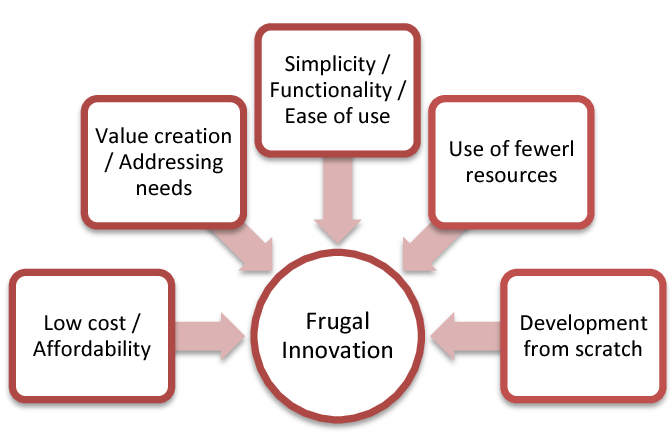Vijay Govindarajan and Chris Trimble, in their book on Reverse Innovation defined the term “Reverse Innovation”; they define it as any idea, which will be first adopted in developing world. This phenomenon was not very common in the past for a simple reason that the rich and affluent that had the ability to demand were mostly concentrated in developed nations. Demand drove the technology and hence most of innovations happened in the west. United States and Germany have about 300 noble laureates in science and technology, while India and China who are six times in population have less than ten of them in total.… Read the rest
Modern Management Concepts
The Emergence of Frugal Innovation
The old innovation paradigm was called closed innovation which was based on the strict control of successful innovation. Under this view, organizations generate their own ideas, develop them, finance them and support them on their own. In short, companies maintain complete control of all aspects of the innovation process and inventions are kept highly secretive. Traditionally many organizations followed this model and it worked well for most of the twentieth century.
However, over the years a number of factors have led to the erosion of the closed innovation approach. First, due to an increase in the mobility and availability of highly educated people, large amounts of knowledge leave the research laboratories of many companies.… Read the rest
The Importance of Going Green
A definition of green management according to is the process within an organization of applying innovation in order to achieve sustainability, waste reduction, social responsibility and a competitive advantage by the aids of continuous learning and development. Organizations shall be doing such developments, by implementing environmental goals and strategies which match the goals and strategies of the organization. This will therefore help the organization to stay focused to its mission and vision.
Nowadays, it is found that companies advertise their products by promoting their environmentally – friendly behavior. It does not matter whether it is on TV or on banner; the message of “go green” is almost always used.… Read the rest
Corporate Social Responsibility as a Source of Competitive Advantage
Corporate Social Responsibility (CSR) means that a corporation should be held accountable for any of its actions that affect people, their communities and their environment; it may require a company to forgo some profits if its social impacts are seriously harmful to the corporation’s stakeholders or if its funds can be used to promote a positive social good. Tougher competition recently has compelled the firms to adopt something that is different from their rivals and has also put a pressure on the firms to examine their philanthropy and other social activities, by doing so the company can sometimes achieve a strategic advantage over its competitors.… Read the rest
What Is Coworking?
One of the grimmest predictions about the future was described by Robert Putnam in his work on social capital. He envisaged low likelihood of participation in community life, smaller groups of friends, even less happiness, and lower perceived quality of life. Furthermore, the enthusiasts of globalization and internet predicted that since people do not have to be together in order to work together, so simply they will not be. Both of these statements are deemed fallacious when recent innovative developments like coworking spaces are considered. Instead of dividing people and further rupturing community life, they reintroduce collaboration and community building through establishing an innovative office design that is being implemented worldwide.… Read the rest
Regeneration of Offices and Modern Approaches to Working
Design of a contemporary workspace has a responsibility to comply with current respect of social change, work flexibility, evolving technology, sustainability and a diverse workplace. Current offices are in need of constant innovative solutions that will sustain the modern way of development in co- working places.
Contemporary offices are in need of stable development and adjustments to existing social principles. Present day work environment has significantly changed throughout the decade. Co-working office spaces are now in need of a relaxed atmosphere. Studies show that contemporary culture in the way people work allow them to prosper better within the business markets. Twenty-first century office design comprises in merging single user and collaborative needs to give the best possible opportunities.… Read the rest





